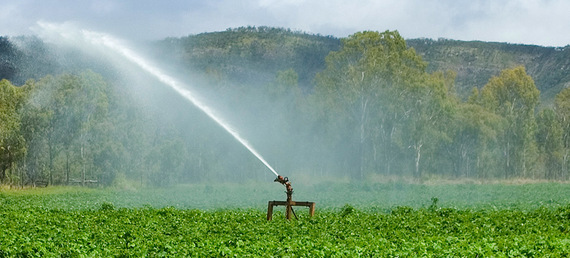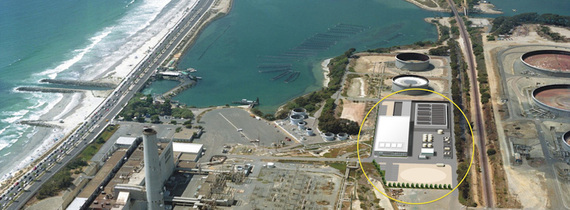
By Don Willlmott
Don Willmott is a New York-based journalist who writes about technology, travel and the environment for a wide variety of publications and websites.
California's drought may end up having a bigger impact on your grocery cart than you realize, and it's not just about almonds and avocados. As ThinkProgress recently noted, California produces 84 percent of the country's fresh peaches, 94 percent of its plums, 99 percent of its artichokes and 94 percent of its broccoli. Almost half of the country's asparagus comes from California as well. Have you noticed prices in the produce aisle inching up? Just wait.
This is why back in April, California Governor Jerry Brown demanded that urban agencies conserve 500 billion gallons of water by February 2016. He did not, however, address the state's agriculture industry, which sucks up 80 percent of the state's available water annually because as Brown noted in interviews, California feeds the nation and the world.
If this devastating drought pattern continues for years -- or decades -- California is going to have to come up with some innovative solutions to address the crisis. What are people talking about today?
Using Industrial Wastewater For Farming
Desperate farmers are taking desperate measures. For example, Chevron's Kern River oil field is selling recycled wastewater leftover from oil production to farmers in Kern County. Every day, Chevron sells 21 million gallons of wastewater to area farmers, which is used on about 45,000 acres, or roughly 10 percent of Kern County farmland. That's 7.6 billion gallons annually -- and it's actually been going on for 20 years. At first glance, this may sound like a scary idea, but is it actually smart?

Interestingly, the leftover wastewater is mixed with walnut shells, a process that's supposed to extract excess oil. Then it flows through treatment ponds before heading down a canal to the Cawelo Water District, where it's diluted with additional fresh water. The local farmers' cooperative pays Chevron $30 an acre-foot for the water, which is half the regular rate.
Both Chevron and the local water district maintain the water is safe for use on crops, noting that testing is done to comply with the wastewater discharge permit issued by the Central Valley water authority. "Protection of people and the environment is a core value for Chevron, and we take all necessary steps to ensure the protection of our water resources," Cameron Van Ast, a company spokesman, told The Los Angeles Times earlier this year.
But testing has gotten tougher. The Central Valley water authority recently ordered wastewater providers to start testing for chemicals covered under California's new fracking disclosure regulations and to report results by June 15. Results of these tests show Chevron's wastewater contains trace amounts oil, benzene and acetone. Still, the company says it is "in compliance with its existing permit." Expect more testing to follow.
Drinking the Ocean
Of course, California sits along side a seeming limitless supply of water -- the Pacific Ocean. Too bad it's so darn salty. Is desalination a solution?
It hasn't been so far. Expensive and energy-hogging, the process appears to have had only limited success wherever it has been tried at scale, and long-time Southern California residents are well aware that one large plant built in Santa Barbara in the early '90s at a cost of about $35 million never got past trial runs once the rains returned and has been sitting idle for more than 20 years. Australia, which has invested $12 billion in six plants, only to see four shuttered, has had a similar experience.
Now, however, a billion-dollar desalination plant under construction next to a lagoon north of San Diego in Carlsbad is scheduled to open in November and is set to provide 50 million gallons of water a day to San Diego County, enough to supply about 112,000 households, according to a Reuters report. Poseidon Resources, the company in charge of the Carlsbad Desalination Project, also has plans for a plant in Huntington Beach. And back in Santa Barbara, the City Council voted last month to spend millions to redesign and reopen its decades-old desalination plant.

The Carlsbad Desalination Project should provide 50 million gallons of water per day. (Source: Carlsbad Desalination Project)
On the upside, desalination helps alleviate the environmental damage of sucking fresh water out of rivers, but on the downside, the ocean takes an environmental hit when plankton and other tiny sea creatures are sucked up and when the leftovers are dumped back in the ocean. Cost isn't as much of an issue anymore, since the cost of imported water has been rising. The important point to remember, Poseidon executive Scott Maloni, told Reuters, is that desalination is supposed to address a chronic problem, not be deployed as an emergency fix to a temporary situation. That raises the question of whether this particular drought can now be classified as "chronic."
Building a Pipeline to Soggy Seattle
In the end, do we need to turn to Captain Kirk to solve this problem? William Shatner, the iconoclastic sci-fi superstar, has been floating what he considers to be an idea that he is sure even Mr. Spock would find eminently logical: just build a pipeline to a place where there's plenty of water. In Shatner's mind, the state of Washington would be perfect. In his plan, which would be bolstered by a $30 billion crowd-funding campaign, a pipeline could easily be laid along the Interstate 5 right of way -- just like they did in Alaska, he likes to note. Although the idea of diverting water from the Columbia River valley and sending it south has come up many times in the past, it's unlikely that it will gain much traction anytime soon, in great part because Washington is also suffering from a statewide drought at the moment.
No problem, says Shatner. Even if his plan fails, he is succeeding in raising awareness of the water issues facing California.
Visit XPRIZE at xprize.org; follow us on Facebook, Twitter and Google+; and get our newsletter to stay informed.